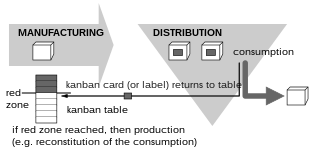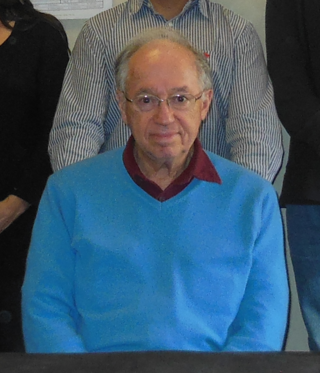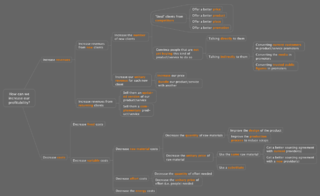Related Research Articles

Ishikawa diagrams are causal diagrams created by Kaoru Ishikawa that show the potential causes of a specific event.

Lean manufacturing is a method of manufacturing goods aimed primarily at reducing times within the production system as well as response times from suppliers and customers. It is closely related to another concept called just-in-time manufacturing. Just-in-time manufacturing tries to match production to demand by only supplying goods that have been ordered and focus on efficiency, productivity, and reduction of "wastes" for the producer and supplier of goods. Lean manufacturing adopts the just-in-time approach and additionally focuses on reducing cycle, flow, and throughput times by further eliminating activities that do not add any value for the customer. Lean manufacturing also involves people who work outside of the manufacturing process, such as in marketing and customer service.

Kanban is a scheduling system for lean manufacturing. Taiichi Ohno, an industrial engineer at Toyota, developed kanban to improve manufacturing efficiency. The system takes its name from the cards that track production within a factory. Kanban is also known as the Toyota nameplate system in the automotive industry.
Kaizen is a concept referring to business activities that continuously improve all functions and involve all employees from the CEO to the assembly line workers. Kaizen also applies to processes, such as purchasing and logistics, that cross organizational boundaries into the supply chain. It has been applied in healthcare, psychotherapy, life coaching, government, manufacturing, and banking.
In science and engineering, root cause analysis (RCA) is a method of problem solving used for identifying the root causes of faults or problems. It is widely used in IT operations, manufacturing, telecommunications, industrial process control, accident analysis, medicine, healthcare industry, etc. Root cause analysis is a form of inductive and deductive inference.
The Toyota Production System (TPS) is an integrated socio-technical system, developed by Toyota, that comprises its management philosophy and practices. The TPS is a management system that organizes manufacturing and logistics for the automobile manufacturer, including interaction with suppliers and customers. The system is a major precursor of the more generic "lean manufacturing". Taiichi Ohno and Eiji Toyoda, Japanese industrial engineers, developed the system between 1948 and 1975.
Ideation is the creative process of generating, developing, and communicating new ideas, where an idea is understood as a basic element of thought that can be either visual, concrete, or abstract. Ideation comprises all stages of a thought cycle, from innovation, to development, to actualization. Ideation can be conducted by individuals, organizations, or crowds. As such, it is an essential part of the design process, both in education and practice.
Troubleshooting is a form of problem solving, often applied to repair failed products or processes on a machine or a system. It is a logical, systematic search for the source of a problem in order to solve it, and make the product or process operational again. Troubleshooting is needed to identify the symptoms. Determining the most likely cause is a process of elimination—eliminating potential causes of a problem. Finally, troubleshooting requires confirmation that the solution restores the product or process to its working state.

Shigeo Shingo was a Japanese industrial engineer who was considered as the world’s leading expert on manufacturing practices and the Toyota Production System.
Single-minute digit exchange of die (SMED) is one of the many lean production methods for reducing inefficiencies in a manufacturing process. It provides a rapid and efficient way of converting a manufacturing process from running the current product to running the next product. This is key to reducing production lot sizes, and reducing uneven flow (Mura), production loss, and output variability.
Genba is a Japanese term meaning "the actual place". Japanese detectives call the crime scene genba, and Japanese TV reporters may refer to themselves as reporting from genba. In business, genba refers to the place where value is created; in manufacturing, the genba is the factory floor. It can be any "site" such as a construction site, sales floor or where the service provider interacts directly with the customer.

Ohno Taiichi was a Japanese industrial engineer and businessman. He is considered to be the father of the Toyota Production System, which inspired Lean Manufacturing in the U.S. He devised the seven wastes as part of this system. He wrote several books about the system, including Toyota Production System: Beyond Large-Scale Production.
Eight Disciplines Methodology (8D) is a method or model developed at Ford Motor Company used to approach and to resolve problems, typically employed by quality engineers or other professionals. Focused on product and process improvement, its purpose is to identify, correct, and eliminate recurring problems. It establishes a permanent corrective action based on statistical analysis of the problem and on the origin of the problem by determining the root causes. Although it originally comprised eight stages, or 'disciplines', it was later augmented by an initial planning stage. 8D follows the logic of the PDCA cycle. The disciplines are:

Accident analysis is a process carried out in order to determine the cause or causes of an accident so as to prevent further accidents of a similar kind. It is part of accident investigation or incident investigation. These analyses may be performed by a range of experts, including forensic scientists, forensic engineers or health and safety advisers. Accident investigators, particularly those in the aircraft industry, are colloquially known as "tin-kickers". Health and safety and patient safety professionals prefer using the term "incident" in place of the term "accident". Its retrospective nature means that accident analysis is primarily an exercise of directed explanation; conducted using the theories or methods the analyst has to hand, which directs the way in which the events, aspects, or features of accident phenomena are highlighted and explained. These analyses are also invaluable in determining ways to prevent future incidents from occurring. They provide good insight by determining root causes, into what failures occurred that lead to the incident.
Autonomation describes a feature of machine design to effect the principle of jidoka (自働化)(じどうか jidouka), used in the Toyota Production System (TPS) and lean manufacturing. It may be described as "intelligent automation" or "automation with a human touch". This type of automation implements some supervisory functions rather than production functions. At Toyota, this usually means that if an abnormal situation arises, the machine stops and the worker will stop the production line. It is a quality control process that applies the following four principles:
- Detect the abnormality.
- Stop.
- Fix or correct the immediate condition.
- Investigate the root cause and install a countermeasure.
Genchi genbutsu (現地現物) literally translates "real location, real thing” and it is a key principle of the Toyota Production System. The principle is sometimes referred to as "go and see." It suggests that in order to truly understand a situation one needs to observe what is happening at the site where work actually takes place: the gemba (現場). One definition is that it is "collecting facts and data at the actual site of the work or problem."

Norman Bodek was a teacher, consultant, author and publisher who published over 100 Japanese management books in English, including the works of Taiichi Ohno and Dr. Shigeo Shingo. He taught a course on "The Best of Japanese Management Practices" at Portland State University. Bodek created the Shingo Prize with Dr. Vern Beuhler at Utah State University. He was elected to Industry Week's Manufacturing Hall of Fame and founded Productivity Press. He was also the President of PCS Press. He died on December 9, 2020, at the age of 88.
Lean dynamics is a business management practice that emphasizes the same primary outcome as lean manufacturing or lean production of eliminating wasteful expenditure of resources. However, it is distinguished by its different focus of creating a structure for accommodating the dynamic business conditions that cause these wastes to accumulate in the first place.

An issue tree, also called logic tree, is a graphical breakdown of a question that dissects it into its different components vertically and that progresses into details as it reads to the right.
The P-Course is a practical training program about Industrial Engineering implemented to teach the main techniques for industrial work improvement. Although especially aimed at applications in manufacturing, it can be useful also to transfer the core concepts of systematic improvement approach to people involved in operational activities in non-manufacturing businesses.
References
- ↑ Olivier D., Serrat (February 2009). The Five Whys Technique. Asian Development Bank. Retrieved September 5, 2019.
- 1 2 Ohno, Taiichi (1988). Toyota production system: beyond large-scale production . Portland, OR: Productivity Press. ISBN 0-915299-14-3.
- ↑ Spear, Steven (12 April 2010). The High Velocity Edge . ISBN 978-0071741415. LCCN 2010280780.[ page needed ]
- ↑ Serrat, Olivier (2017). "The Five Whys Technique". Knowledge Solutions. pp. 307–310. doi:10.1007/978-981-10-0983-9_32. ISBN 978-981-10-0982-2.
- ↑ Fantin, Ivan (2014). Applied Problem Solving. Method, Applications, Root Causes, Countermeasures, Poka-Yoke and A3. ISBN 978-1499122282.
- ↑ Ohno, Taiichi (March 2006). ""Ask 'why' five times about every matter."". Archived from the original on Nov 27, 2022. Retrieved September 5, 2019.
- ↑ Semler, Ricardo (2004). The Seven-Day Weekend . Penguin. ISBN 9781101216200.
Ask why. Ask it all the time, ask it any day, and always ask it three times in a row.
- ↑ Bulsuk, Karn (April 2, 2009). "An Introduction to 5-why" . Retrieved September 5, 2019.
- ↑ Bulsuk, Karn (July 7, 2009). "5-whys Analysis using an Excel Spreadsheet Table" . Retrieved September 5, 2019.
- ↑ "The "Thinking" Production System: TPS as a winning strategy for developing people in the global manufacturing environment" (PDF). Public Affairs Division, Toyota Motor Corporation. October 8, 2003. Archived from the original (PDF) on November 21, 2020. Retrieved September 5, 2019.
- 1 2 Card, Alan J. (August 2017). "The problem with '5 whys'". BMJ Quality & Safety . 26 (8): 671–677. doi: 10.1136/bmjqs-2016-005849 . PMID 27590189. S2CID 42544432.